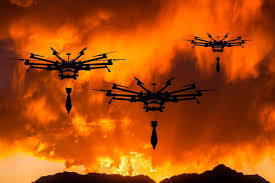War Swarm Drones: The Future of Autonomous Warfare

The advent of drone technology has already revolutionized modern warfare, but swarm drones represent the next leap. Unlike traditional drones, which are typically operated individually, swarm drones function as a coordinated, self-organizing unit. Drawing inspiration deneme bonusu veren sitelerfrom the natural world—such as swarms of bees or schools of fish—these autonomous drones have the potential to change the face of warfare. This blog will delve into what war swarm drones are, how they work, and their potential impact on future military operations.
What Are War Swarm Drones?
Swarm drones are a group of small, unmanned aerial vehicles (UAVs) that are designed to work together toward a common objective. Unlike conventional drones, which require direct human control, swarm drones rely on artificial intelligence (AI) and sophisticated algorithms to operate independently. Each drone within the swarm can communicate with the others, sharing information and adapting to new situations in real-time, much like a flock of birds that changes direction collectively without an obvious leader.
The individual drones in a swarm are typically smaller and cheaper than larger military UAVs, but their strength lies in numbers. A swarm can consist of dozens or even hundreds of drones, overwhelming enemy defenses through sheer volume while still being highly flexible and adaptive.
How Do Swarm Drones Work?
Swarm drones are powered by cutting-edge AI, machine learning, and real-time data processing. Each drone in the swarm is equipped with sensors and communication systems that allow it to exchange data with other drones in the swarm. Through algorithms inspired by collective behavior models, the drones can autonomously decide on flight paths, attack strategies, and even adapt to losses within the swarm.
Key Components of a War Swarm Drone System:
- AI and Machine Learning: These are at the heart of swarm functionality. Machine learning allows drones to recognize patterns, predict movements, and make real-time decisions based on changing environments.
- Autonomous Navigation: Using GPS, lidar, and other sensors, swarm drones can navigate complex environments without direct human input.
- Intercommunication: Each drone is in constant communication with others in the swarm, allowing the group to act as a cohesive unit rather than as individual drones.
- Decentralized Control: Rather than having a central hub for decision-making, control is decentralized. This makes the swarm resilient—if one drone is disabled, the others continue their mission without disruption.
Applications in Warfare
Swarm drones have the potential to transform modern military strategies. Here are some of their key applications:
1. Offensive Capabilities
In an offensive scenario, swarm drones can be used to carry out precision strikes. Equipped with miniaturized explosives, they can target enemy positions, vehicles, or infrastructure. The sheer number of drones can overwhelm traditional defense systems, which may be able to shoot down one or two drones but struggle to cope with hundreds attacking simultaneously.
2. Surveillance and Reconnaissance
Swarm drones can be deployed for surveillance purposes in hostile environments, gathering real-time intelligence on enemy movements, terrain, or other critical data. The swarm’s ability to cover vast areas quickly and operate in tandem ensures that the data collected is both extensive and accurate.
3. Electronic Warfare
Swarm drones can also be used for electronic warfare. By jamming enemy radar and communication systems, they can create confusion and disrupt the adversary's ability to coordinate defenses.
4. Search and Rescue
In humanitarian contexts, military swarm drones can be adapted for search and rescue missions, especially in difficult-to-access terrain. Their ability to cover large areas quickly makes them ideal for locating missing personnel or survivors in disaster scenarios.
Challenges and Ethical Considerations
While swarm drones present significant advantages, their use in warfare comes with several challenges and ethical concerns:
1. Autonomy and Accountability
One of the key concerns surrounding swarm drones is the level of autonomy they are granted. Since the drones operate without direct human control, it becomes difficult to attribute accountability for mistakes or unintended damage.
2. Security and Vulnerability
Despite their decentralized nature, swarm drones are still vulnerable to hacking, jamming, or other forms of cyberattacks. An enemy capable of compromising the communication network between the drones could potentially disrupt or even control the swarm.
3. Escalation of Warfare
The development of autonomous drones could lead to an arms race, where countries invest heavily in drone technology to maintain superiority. The widespread deployment of swarm drones could also make warfare more frequent and less human-involved, increasing the risk of unintended conflicts.
The Future of War Swarm Drones
Swarm drones are still in the early stages of military deployment, but as AI, robotics, and communication technology continue to advance, their role in warfare is expected to grow significantly. The integration of swarm drones into military arsenals around the world is likely to transform the dynamics of future conflicts, offering both new opportunities and new challenges.
In the near future, swarm drones could become a standard tool in military operations, capable of executing highly coordinated attacks, gathering vital intelligence, and even engaging in electronic warfare. However, as these technologies develop, it is crucial for governments, militaries, and international bodies to address the ethical and security implications they present.
Conclusion
War swarm drones represent a paradigm shift in autonomous warfare, combining the power of AI with the flexibility of UAVs. Their potential to carry out complex missions with minimal human intervention makes them a powerful tool for future military operations. However, with this power comes significant responsibility, and the ethical implications of their use must be carefully considered as these technologies advance.